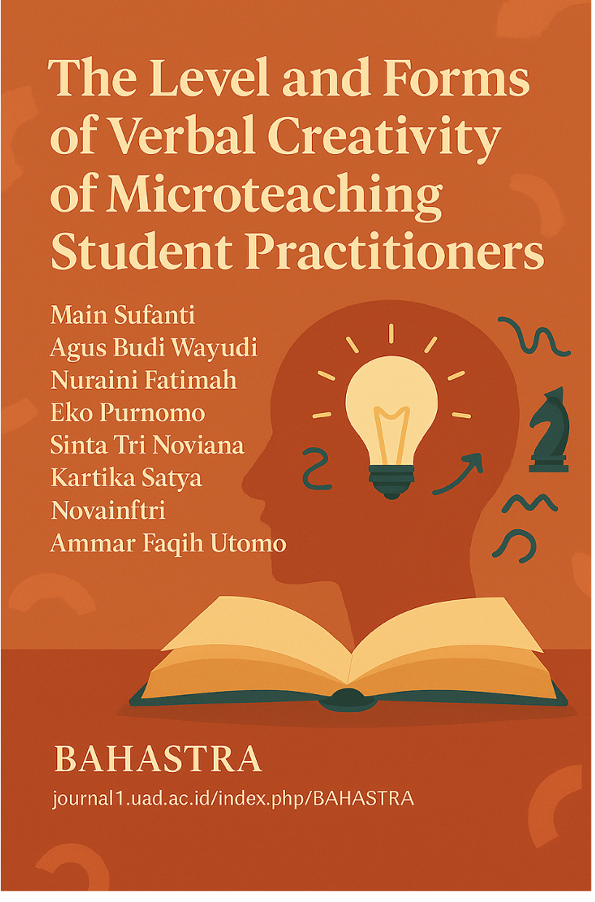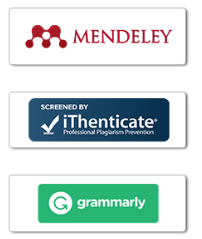The level and forms of verbal creativity of microteaching student practitioners
DOI:
https://doi.org/10.26555/bs.v45i2.1624Keywords:
Elaboration , Flexisibilty , Fluency , Microteaching , Verbal CreativityAbstract
This study aims to describe the verbal creativity of student practitioners in the Microteaching course. The aspects discussed include verbal creativity based on the categories of flexibility, fluency, originality, and elaboration. Each category is described based on the level of scores (high or low) and the corresponding forms. The results of this study show that: (a) the level of fluency of students in generating many ideas is highest in word production. The forms of word production in the fluency category, based on the most frequently produced word classes, are nouns. Based on word meaning, most students tend to produce denotative meanings. This reflects a tendency to use words in their general or literal sense. (b) the level of flexibility of microteaching student practitioners is high. In terms of form, student practitioners demonstrate high flexibility in sentence form and sentence use, but lower in sentence length, imagination, and fantasy. (c) the level of originality of microteaching student practitioners is high. The forms of students’ verbal creativity originality include five aspects: originality in theme, original solution or ending, humorous elements in sentences, the use of self-created words or names, and the originality of the respondent’s writing style. (d) the level of elaboration of student practitioners is high. Meanwhile, the forms of elaboration include four aspects: aesthetic quality, emotional content, empathy, and personal elements, while the elements of direct narrative sentence conversation and the use of quotations are not fulfilled.
References
Ahmed, S. T., & Feist, G. J. (2021). The language of creativity: Validating linguistic analysis to assess creative scientists and artists. Frontiers in Psychology, 12(November), 1–15. https://doi.org/10.3389/fpsyg.2021.724083
Alabbasi, A. M. A., Paek, S. H., Kim, D., & Cramond, B. (2022). What do educators need to know about the Torrance tests of creative thinking: A comprehensive review. Frontiers in Psychology, 13, 1000385. https://doi.org/10.3389/fpsyg.2022.1000385
Borgianni, Y., Maccioni, L., Fiorineschi, L., & Rotini, F. (2020). Forms of stimuli and their effects on idea generation in terms of creativity metrics and non-obviousness. International Journal of Design Creativity and Innovation, 8(3), 147–164. https://doi.org/10.1080/21650349.2020.1766379
Darsinah, D., Salsabila, A., & Febriana, S. (2021). Development of guidelines for micro teaching in early children education faculty of Universitas Muhammadiyah Surakarta. Cakrawala Dini: Jurnal Pendidikan Anak Usia Dini, 12(2), 159–167. https://doi.org/10.17509/cd.v12i2.37463
Dulay, S. (2023). What makes an effective teacher? Unveiling teachers ’ perceptions. Journal of Pedagogical Sociology and Psychology, 5(3), 112–130. https://doi.org/10.33902/jpsp.202323606
Etikan, I., Musa, S. A., & Alkassim, R. S. (2016). Comparison of convenience sampling and purposive sampling. American Journal of Theoretical and Applied Statistics, 5(1), 1–4. https://doi.org/10.11648/j.ajtas.20160501.11
Fausan, M. M., Hakim, S., & Pujiastuti, I. P. (2024). Transformation of technology literacy and creative thinking skills of prospective biology teachers through interactive microteaching. Journal of Education Research, 5(4), 5229–5238. https://doi.org/10.37985/jer.v5i4.1801
Fitriati, F., Rosli, R., Iksan, Z., & Hidayat, A. (2024). Exploring challenges in preparing prospective teachers for teaching 4C skills in mathematics classroom: A school-university partnership perspectives. Cogent Education, 11(1). https://doi.org/10.1080/2331186X.2023.2286812
Grossman, P., Hammerness, K., & McDonald, M. (2009). Redefining teaching, re‐imagining teacher education. Teachers and Teaching: Theory and Practice, 15(2), 273–289. https://doi.org/10.1080/13540600902875340
Guilford, J. P. (1967). Creativity: Yesterday, today, and tomorrow. The Journal of Creative Behavior, 1(1), 3–14. https://doi.org/10.1002/j.2162-6057.1967.tb00002.x
Hagège, H., Ourmi, M. El, Shankland, R., Arboix-Calas, F., Leys, C., & Lubart, T. (2023). Ethics and meditation: A new educational combination to boost verbal creativity and sense of responsibility. Journal of Intelligence, 11(8). https://doi.org/10.3390/jintelligence11080155
Halliday, M. A. K., & Matthiessen, C. M. I. M. (2013). Halliday’s introduction to functional grammar. Routledge. https://doi.org/10.4324/9780203431269
Hasby, N., Luardini, M. A., Perdana, I., Noor, P., & Kodriyah, L. (2025). Teacher speech style and student engagement in ELT: A systematic review. INTERACTION: Jurnal Pendidikan Bahasa, 12(1), 166–175. https://doi.org/10.36232/interactionjournal.v12i1.1918
Hayati, Y., Ningsih, A. G., Rasyid, Y., & Affendi, P. M. D. D. N. R. N. M. (2025). The influence of R2L-based HOTS learning on narrative text writing skills for junior high school students. Bahastra, 45(1), 9–17. https://doi.org/10.26555/bs.v45i1.1013
Herrera, R. F., Vielma, J. C., & La Rivera, F. M. (2018). Impact of Microteaching on Engineering Students’ Communication Skills. International Journal of Engineering Education, 34(6), 1768–1775.
Hoffmann, T. (2024). The 5c model of linguistic creativity: Construction grammar as a cognitive theory of verbal creativity. Journal of Foreign Languages and Cultures, 8(1), 139–154. https://doi.org/10.53397/hunnu.jflc.202401011
Huda, M., Sulistyonob, Y., Soleh, A. R., & Retikae, N. D. (2025). Element of students’ creative thinking skills: A critical evaluation of senior high school Indonesian textbooks. Bahastra, 45(1), 18–30. https://doi.org/10.26555/bs.v45i1.1134
Hußner, I., Lazarides, R., Richter, E., Westphal, A., & Symes, W. (2023). Reflect on your teaching experience: Systematic teachers self-efficacy for reflection. Zeitschrift Für Erziehungswissenschaft, 26, 1301–1320. https://doi.org/10.1007/s11618-023-01190-8
Iliasova, L., Nekrasova, I., Mena, J., & Estrada-Molina, O. (2025). Microteaching on pre-service teachers’ education: Literature review. Frontiers in Education, 10, 1562975. https://doi.org/10.3389/feduc.2025.1562975
İşler, N. K., Gosen, M. N., & Willemsen, A. (2024). Hypothetical situations as a pedagogical resource in social studies and history lessons at primary school. International Journal of Educational Research, 125, 102315. https://doi.org/10.1016/j.ijer.2024.102315
Jarvie, S., & Beymer, A. (2020). “We do investigate ourselves”: Figurative assessment practices as meaning-making in English education. Changing English, 27(2), 152–162. https://doi.org/10.1080/1358684X.2019.1647512
Kamal, A., Ibrohim, I., & Susilo, H. (2024). Preservice teachers reflections on lesson study integration into a microteaching course. Social Sciences & Humanities Open, 10, 101140. https://doi.org/10.1016/j.ssaho.2024.101140
Kaplan, D., & Berman, R. (2015). Developing linguistic flexibility across the school years. First Language, 35(1), 27–53. https://doi.org/10.1177/0142723714566335
Koesnadi, L. P., & Astuti, R. (2024). Analisis kesesuaian dan kelengkapan modul ajar terhadap standar kompetensi microteaching. Journal of Education Research, 5(4), 5479–5487. https://doi.org/10.37985/jer.v5i4.1726
Le Normand, M. T., & Chevrie-Muller, C. (1991). Individual differences in the production of word classes in eight specific language-impaired preschoolers. Journal of Communication Disorders, 24(5–6), 331–351. https://doi.org/10.1016/0021-9924(91)90007-6
Leshem, R., Heltai, S. H., & Mashal, N. (2023). Personality traits and environment: The effects of observing visual art on verbal creativity. Progress in Brain Research, 277, 85–108. https://doi.org/10.1016/bs.pbr.2022.12.006
Li, M., & Zhang, L. (2025). Word class effects on l2 Chinese word associations. SAGE Open, 15(1), 21582440251329550. https://doi.org/10.1177/21582440251329552
Miles, M. B., Huberman, A. M., & Saldaña, J. (2014). Qualitative data analysis: A methods sourcebook (3rd). Sage.
Moelong, L. (2017). Metodologi penelitian pendidikan edisi revisi. Remaja Rosdakarya.
Monteiro, V., Mata, L., Santos, N., Sanches, C., & Gomes, M. (2019). Classroom talk: The ubiquity of feedback. Frontiers in Education, 4, 140. https://doi.org/10.3389/feduc.2019.00140
Mufid, M., & Li’illiyyina, I. M. (2024). The influence of microteaching effectiveness on teaching skills and readiness: A study of islamic education students. TA’DIBUNA: Jurnal Pendidikan Agama Islam, 7(2), 164–177. https://doi.org/10.30659/jpai.7.2.164-177
Mukuka, A., & Alex, J. K. (2024). Review of research on microteaching in mathematics teacher education: Promises and challenges. Eurasia Journal of Mathematics, Science, and Technology Education, 20(1), 1–15. https://doi.org/10.29333/ejmste/13941
Munandar, U. (2009). Pengembangan kreativitas anak berbakat. Rineka Cipta.
___________. (2016). Pengembangan kreativitas anak berbakat. Rineka Cipta.
Murray, N., Liddicoat, A. J., Zhen, G., & Mosavian, P. (2023). Constraints on innovation in English language teaching in hinterland regions of China. Language Teaching Research, 27(5), 1246–1267. https://doi.org/10.1177/1362168820979855
Nasution, T., Meliani, F., Purba, R., Saputra, N., & Herman, H. (2023). Participation performance of students’ basic teaching skills in microteaching. AL-ISHLAH: Jurnal Pendidikan, 15(2), 2441–2448. https://doi.org/10.35445/alishlah.v14i4.2307
Noddings, N. (2013). Caring: A relational approach to ethics and moral education. Univ of California Press.
O’Flaherty, J., Lenihan, R., Young, A. M., & McCormack, O. (2023). Developing micro-teaching with a focus on core practices: The use of approximations of practice. Education Sciences, 14(1), 35. https://doi.org/10.3390/educsci14010035
Pratama, G. (2019). Basic communication skill drill in microteching context to improve the teching skills of civil engineering and planning education students, faculty of engineering, Yogyakarta State University. IOP Conference Series: Materials Science and Engineering, 535(1), 12014. https://doi.org/10.1088/1757-899X/535/1/012014
Qamar, M. T., Yasmeen, J., Pathak, S. K., Sohail, S. S., Madsen, D. Ø., & Rangarajan, M. (2024). Big claims, low outcomes: Fact checking ChatGPT’s efficacy in handling linguistic creativity and ambiguity. Cogent Arts and Humanities, 11(1). https://doi.org/10.1080/23311983.2024.2353984
Ramang, R. (2023). Microteaching learning strategies and their roles to improve teaching ability of teacher students at Islamic higher education. Journal of Innovation in Educational and Cultural Research, 4(1), 109–121. https://doi.org/10.46843/jiecr.v4i1.468
Remesh, A. (2013). Microteaching, an efficient technique for learning effective teaching. Journal of Research in Medical Sciences: The Official Journal of Isfahan University of Medical Sciences, 18(2), 158.
Richards, J. C., & Lockhart, C. (1994). Reflective teaching in second language classrooms. Cambridge University Press. https://doi.org/10.1017/CBO9780511667169
Samuelsson, M., Samuelsson, J., & Thorsten, A. (2022). Simulation training-a boost for pre-service teachers efficacy beliefs. Computers and Education Open, 3, 100074. https://doi.org/10.1016/j.caeo.2022.100074
Sari, N. M., & Rohmah, W. (2023). Influence micro teaching and Plp Ii on interest in becoming a teacher students of accounting education Muhammadiyah University Surakarta. Conference Proceedings International Cenference on Education Innovation and Social Science, July, 664–671.
Satriawan, M. J., Padlurrahman, & Mohzana. (2023). Hubungan antara kemampuan membaca pemahaman, penguasaan kosa kata, dan sikap bahasa dengan keterampilan menulis ringkasan siswa di sekolah dasar. BADA’A: Jurnal Ilmiah Pendidikan Dasar, 5(2), 352–260. https://doi.org/10.37216/badaa.v5i2.1174
Schwartz, M. (2021). Language-conducive strategies in early language education. Springer. https://doi.org/10.1007/978-3-030-47073-9_24-2
Sezaki, H., Lei, Y., Xu, Y., Hachisuka, S., Warisawa, S., & Kurita, K. (2023). Online technology-based microteaching in teacher education: A systematic literature review. Procedia Computer Science, 225, 2487–2496. https://doi.org/10.1016/j.procs.2023.10.240
Smit, N., Dijk, M. Van, Bot, K. De, & Lowie, W. (2022). The complex dynamics of adaptive teaching: Observing teacher-student interaction in the language classroom. International Review of Applied Linguistics in Language Teaching, 60(1), 23–40. https://doi.org/10.1515/iral-2021-0023
Sudaryanto. (2015). Metode dan aneka teknik analisis bahasa. Duta Wacana University Press.
Sufanti, M., Pratiwi, D. R., Fatimah, N., Cahyati, J. N., Noviana, S. T., Febriyanti, R., & Purnomo, E. (2024). Microteaching model adaptasi. Muhammadiyah University Press.
Sufanti, M., Pratiwi, D. R., & Sholeh, K. (2022). Adaptasi program microteaching bagi calon guru bahasa Indonesia pada masa pandemi covid-19. Jurnal Penelitian Humaniora, 23(1), 21–34. https://doi.org/10.23917/humaniora.v23i1.19161
Sugiyono. (2017). Metode kuantitatif, kualitatif, dan R&D. Alfabeta.
Sukiman, S., Priyatni, E. T., & Suwignyo, H. (2023). The use of project based learning in microteaching courses to instill students creative thinking ability. Jurnal Pedagogi dan Pembelajaran, 6(1), 89–97. https://doi.org/10.23887/jp2.v6i1.54540
Tiwa, T. (2023). Pengaruh kreativitas verbal terhadap keterampilan berbicara pada mahasiswa program studi Psikologi Universitas Negeri Manado Tellma. Jurnal Ilmiah Wahana Pendidikan, 9(15), 1–23.
Tong, Y., & Ding, Y. (2025). Productive classroom dialogue and its association with student achievement in knowledge-building environments. Language and Education, 39(1), 232–251. https://doi.org/10.1080/09500782.2024.2323207
Torrance, E. P. (1966). Torrance tests of creative thinking. Educational and Psychological Measurement.
Torrance, E. P. (1974). Retooling education for creative talent: How goes it? Gifted Child Quarterly, 18(4), 233–239. https://doi.org/10.1177/001698627401800401
Tsui, A. (2003). Understanding expertise in teaching: Case studies of second language teachers. Cambridge University Press. https://doi.org/10.1017/CBO9781139524698
Vígh, T. (2024). Development of research skills through research-focused microteaching lesson study in preservice teacher education. Teaching and Teacher Education, 145, 104618. https://doi.org/10.1016/j.tate.2024.104618
Wang, K., & Nickerson, J. V. (2019). A wikipedia-based method to support creative idea generation: The role of stimulus relatedness. Journal of Management Information Systems, 36(4), 1284–1312. https://doi.org/10.1080/07421222.2019.1661095
Wulandari, V. D., & Wirdati, W. (2024). The effect of microteaching lectures in improving nine basic teaching skills for university students. Ahlussunnah: Journal of Islamic Education, 3(1), 20–31. https://doi.org/10.58485/jie.v3i1.223
Zalavra, E., & Makri, K. (2022). Relocating online a technology-enhanced microteaching practice in teacher education: Challenges and implications. Electronic Journal of E-Learning, 20(3), 270–283. https://doi.org/10.34190/ejel.20.3.2180
Zitha, I., Mokganya, G., & Sinthumule, O. (2023). Innovative strategies for fostering student engagement and collaborative learning among extended curriculum programme students. Education Sciences, 13(12), 1196. https://doi.org/10.3390/educsci13121196

Downloads
Published
Issue
Section
License
Copyright (c) 2025 Main Sufanti, Agus Budi Wahyudi, Nuraini Fatimah, Eko Purnomo, Sinta Tri Noviana, Kartika Satya Noviafitri, Ammar Faqih Utomo

This work is licensed under a Creative Commons Attribution-ShareAlike 4.0 International License.

1.jpg)






